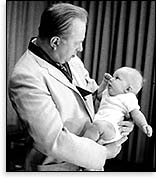

The Way to Happiness is a common-sense guide to better living. A testimony to the regard in which he held men of goodwill, no matter their faith, L. Ron Hubbard wrote this moral code for use by adults and children of all faiths.
It contains 21 precepts for successful living in a modern world. The following, Precept 4, is included here.

oday’s children will become tomorrow’s civilization. Bringing a child into the world today is a little bit like dropping one into a tiger’s cage. Children can’t handle their environment and they have no real resources. They need love and help to make it.
It is a delicate problem to discuss. There are almost as many theories on how to raise a child or not raise him as there are parents. Yet if one does it incorrectly much grief can result and one may even complicate his or her own later years. Some try to raise children the way they were themselves raised, others attempt the exact opposite, many hold to an idea that children should just be let grow on their own. None of these guarantee success. The last method is based on a materialistic idea that the development of the child parallels the evolutionary history of the race; that in some magical way, unexplained, the “nerves” of the child will “ripen” as he or she grows older and the result will be a moral, well-behaving adult. Although the theory is disproven with ease — simply by noticing the large criminal population whose nerves somehow did not ripen — it is a lazy way to raise children and achieves some popularity. It doesn’t take care of your civilization’s future or your older years.
A child is a little bit like a blank slate. If you write the wrong things on it, it will say the wrong things. But, unlike a slate, a child can begin to do the writing: the child tends to write what has been written already. The problem is complicated by the fact that, while most children are capable of great decency, a few are born insane and today, some are even born as drug addicts: but such cases are an unusual few.
It does no good just to try to “buy” the child with an overwhelm of toys and possessions or to smother and protect the child: the result can be pretty awful.
One has to make up his mind what he is trying to get the child to become. This is modified by several things: a) what the child basically can become due to inherent makeup and potential; b) what the child, himself, really wants to become; c) what one wants the child to become; d) the resources available. But remember that whatever these all add up to, the child will not survive well unless he or she eventually becomes self-reliant and very moral. Otherwise the end product is likely to be a liability to everyone including the child.
Whatever is one’s affection for the child, remember that the child cannot survive well in the long run if he or she does not have his or her feet put on the way to survival. It will be no accident if the child goes wrong: the contemporary society is tailor-made for a child’s failure.
It will help enormously if you obtain a child’s understanding of and agreement to follow the precepts contained in The Way to Happiness.
What does have a workability is simply to try to be the child’s friend. It is certainly true that a child needs friends. Try to find out what a child’s problem really is and without crushing their own solutions, try to help solve them. Observe them — and this applies even to babies. Listen to what children tell you about their lives. Let them help — if you don’t, they become overwhelmed with a sense of obligation which they then must repress.
It will help the child enormously if you obtain understanding of and agreement to this way to happiness and get him or her to follow it. It could have an enormous effect on the child’s survival — and yours.
A child factually does not do well without love. Most children have an abundance of it to return.
The way to happiness has on its route the loving and the helping of children from babyhood to the brink of adult life.

|







